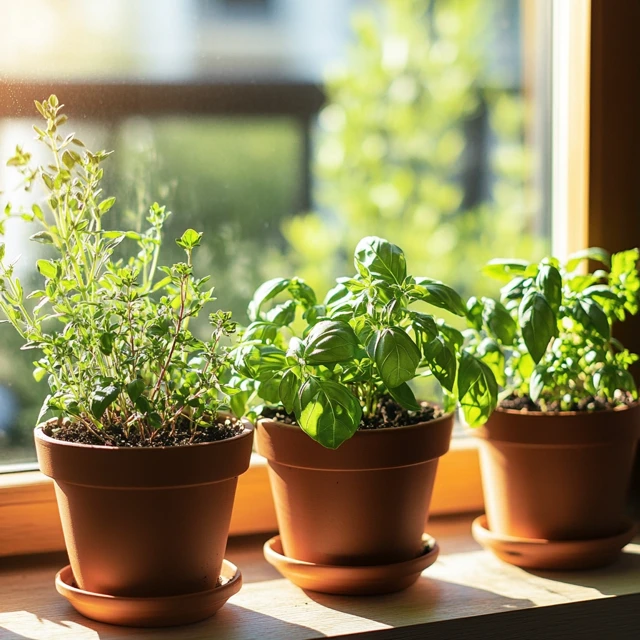Introduction: Why Grow Your Own Herbs?
Nothing elevates a meal quite like fresh herbs—imagine snipping a sprig of basil or parsley
right before cooking. Growing herbs at home doesn't require a large outdoor space or extensive
gardening knowledge. Even a sunny windowsill can yield aromatic, delicious leaves ready to garnish
your dishes.
In this guide, we'll walk through the basics of setting up a small herb garden, choosing the right
plants for your environment, and ensuring they thrive year-round. From pots on your balcony to a
simple indoor planter, let's get started nurturing your own flavorful green corner.
1. Choosing the Right Herbs
Not all herbs are created equal—some require more sunlight or drainage, while others adapt
well to partial shade. Consider:
- Ease of Growth: Beginner-friendly herbs include basil, chives, mint,
oregano, and parsley. They're quite forgiving and grow quickly.
- Sunlight Needs: Most culinary herbs (like rosemary, thyme, basil) love
6+ hours of sun. If your spot is shady, opt for mint or chives that can tolerate partial
shade.
- Climate & Temperature: If indoors, a consistent temperature is fine.
Outdoors, check if your climate suits perennial herbs (rosemary, sage) or annuals (basil).
- Culinary Preferences: Focus on herbs you cook with often—like cilantro
for Mexican dishes or dill for pickling. That ensures they don't go unused.
Starting with a few key herbs prevents overwhelm and helps you gauge which ones thrive in
your space.
2. Deciding Where to Plant: Indoor vs. Outdoor
Herbs can grow in many settings—a bright kitchen windowsill or a small balcony container.
Each option has pros and cons:
- Indoor Windowsill: Convenient for cooking access, stable temperatures,
but limited direct sunlight unless you have south-facing windows. Good for year-round
growth if properly lit.
- Balcony or Patio: Typically more sunlight exposure, potential for
larger pots, but you must consider weather fluctuations. Make sure there's enough wind
protection and check if building rules allow planters on railings.
- Raised Beds in Small Gardens: If you have a tiny backyard, dedicating
a raised bed or corner can produce bountiful herbs. Just ensure decent soil and at least
partial sun daily.
- Vertical or Hanging Options: For very tight spaces, use vertical
planters or hanging pots to maximize your growing area.
Assess how much sun your chosen spot gets and pick an area where you can easily water
and harvest your plants.
3. Containers & Soil Choices
Proper containers and soil set the stage for healthy herb growth. Keep these points in mind:
- Drainage is Vital: Herbs hate soggy roots. Ensure pots have drainage
holes, and layer some pebbles at the bottom if necessary.
- Pot Size: A 6- to 8-inch pot is enough for most single herbs. Larger
planters can house multiple herbs if each has enough room for root expansion.
- Soil Mix: Use a quality potting mix that retains moisture but drains
well. Adding perlite or coarse sand can improve aeration. Avoid garden soil in containers,
as it may compact or harbor pests.
- Reuse & Upcycle: Old tins, wooden crates, or ceramic bowls (with
drainage added) can become unique planters—just ensure they're food-safe if you do
direct planting.
Healthy roots lead to robust herbs, so investing in decent soil and appropriate containers
pays off in lush growth.
4. Planting & Day-to-Day Care
Whether you're starting from seeds or purchasing seedlings, follow these guidelines:
- Seeds vs. Seedlings: For quick results, buy seedlings from a garden
center. Seeds are cheaper but take longer to sprout. Basil, cilantro, and chives are
relatively easy from seed.
- Transplanting: If moving from nursery pots, gently loosen the root
ball before placing in your chosen pot. Water thoroughly afterward to reduce transplant
shock.
- Watering Schedule: Herbs generally prefer slightly moist but not
waterlogged soil. Water when the top inch feels dry—over-watering leads to root rot,
while under-watering causes wilting.
- Fertilizing Lightly: A balanced, organic fertilizer once a month
usually suffices. Over-fertilizing can produce lots of foliage but less flavor.
Observe each herb's leaves—yellowing may indicate over-watering or nutrient deficiency,
while drooping can signal under-watering or heat stress.
5. Sunshine & Microclimates
Herbs typically love sunlight, but not all windows or balconies have the same exposure:
- Full Sun Herbs: Rosemary, thyme, sage, and basil thrive in 6+ hours
of direct sun. If you only have partial sun, expect slower growth but still possible
success.
- Partial Shade Tolerant: Mint, chives, parsley can handle around
4 hours of sun or bright dappled light.
- Rotate Pots: If one side of your pot faces a stronger sun source,
rotate weekly for even growth. This also helps if leaves lean toward the sun.
- Protect from Harsh Elements: If it's extremely hot or windy,
place a shade cloth or move pots indoors. Sudden temperature swings can shock
delicate herbs.
Tailor your herb selection to your available sun, ensuring each plant receives the
conditions it needs to flourish.
6. Keeping Pests & Diseases at Bay
Nothing's more frustrating than watching leaves yellow or holes appear from pests.
Tackle issues early:
- Inspect Leaves Weekly: Look under leaves for aphids, spider mites,
or whiteflies. Catching them early stops widespread damage.
- Use Natural Remedies: Insecticidal soap or neem oil spray can
deter common pests. A gentle wipe with soapy water can remove small infestations.
- Encourage Airflow: Crowded, damp conditions breed fungus.
Space pots to let air circulate, and avoid overhead watering if possible.
- Quarantine Sick Plants: If one herb shows severe disease,
isolate it before it spreads to the entire batch. Consider repotting or discarding
heavily infected plants.
Organic, preventative methods typically suffice for small home herb gardens,
avoiding chemicals that might affect flavor.
7. Harvesting & Using Your Herbs
The reward of homegrown herbs is savoring them in your favorite dishes. Proper harvesting ensures
continuous growth:
- Pinch Top Leaves First: For basil, mint, or oregano, snip top sets
of leaves regularly to promote bushiness and prevent flowering (which can make flavors bitter).
- Morning Harvest: Essential oils peak in early morning, so picking
leaves around then can yield the best flavor and aroma.
- Store Extra Wisely: Wrap stems in damp paper towels in the fridge
or dry them for longer shelf life. Alternatively, freeze chopped herbs in olive oil
cubes for ready-to-use seasonings.
- Continual Light Pruning: For perennial herbs like rosemary or sage,
trim lightly to keep them from getting woody and to encourage fresh shoots.
Frequent harvesting actually benefits most herbs, preventing them from going to seed
too soon and keeping them lush.
Popular Herbs & Quick Care Tips
| Herb |
Light Requirement |
Watering Frequency |
Key Notes |
| Basil |
Full sun (6+ hrs) |
Moderate (keep soil slightly moist) |
Pinch off flowers to extend leaf production |
| Mint |
Partial sun okay |
Regular (moist soil, but not soaked) |
Grows aggressively—contain in pots |
| Rosemary |
Full sun |
Light watering (drought tolerant) |
Allow soil to dry a bit between waterings |
| Parsley |
Partial to full sun |
Moderate (soil evenly moist) |
Biennial: harvest leaves in first year for best flavor |
| Chives |
Full sun to partial |
Moderate (don't let fully dry out) |
Edible flowers make a great garnish |
Adjust watering depending on your specific climate—hotter environments might require
more frequent checks, cooler or humid areas less so.
Conclusion
Growing herbs at home—even in limited spaces—brings multiple rewards: fresh flavors,
aromatic greenery, and the simple pleasure of nurturing living plants. By selecting
herbs suited to your light conditions, choosing quality soil, and harvesting properly,
you'll enjoy a steady supply of tasty leaves for your kitchen adventures.
Whether perched on a sunny windowsill or thriving on your balcony, a small herb garden
injects life and flavor into any home. So roll up your sleeves, pick a few favorite
herbs, and watch your mini oasis flourish—one leaf at a time!

